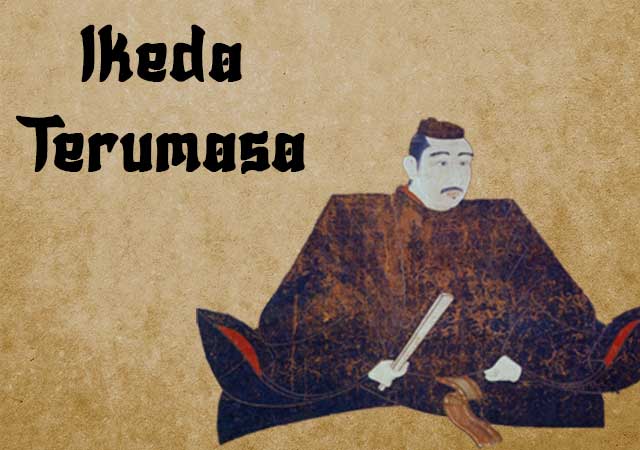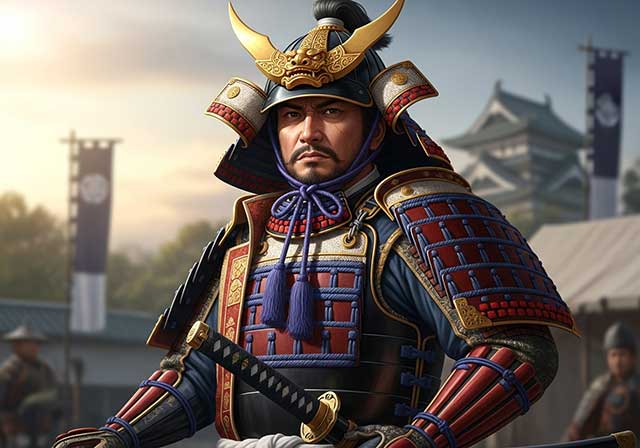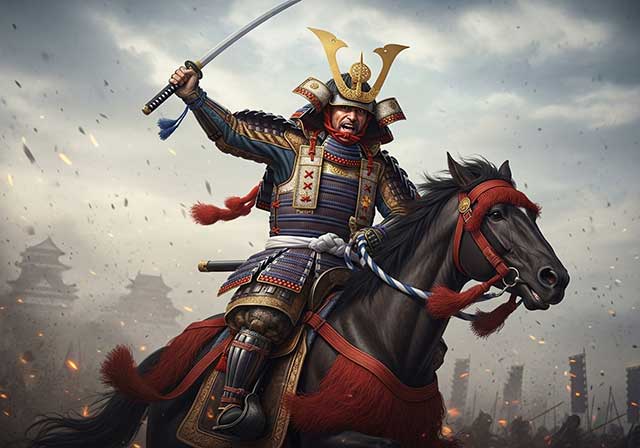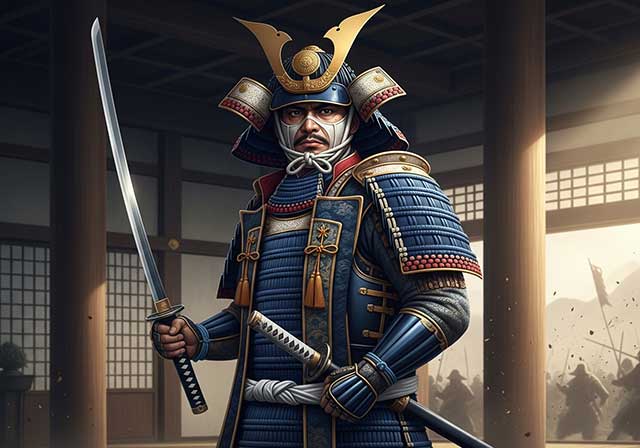
Ikeda Terumasa (January 31, 1565 – March 16, 1613) was a Japanese daimyo of the early Edo period, recognized by his court title, "Musashi no Kami," and known as the "Shogun of Western Japan." Terumasa, a distinguished military leader, participated in numerous significant battles during the late Azuchi-Momoyama period. His service at the Battle of Sekigahara earned him control over the Himeji domain. Originally named Araokojimaru, he was the son of Ikeda Tsuneoki and the brother of Ikeda Sen. He later became the heir to Ikeda Nobuteru and held Ikejiri Castle in Mino Province.
In 1579, during the Siege of Itami, Terumasa and his father guarded Settsukura Bridge, and during the 1580 Siege of Hanakuma Castle, Terumasa distinguished himself in combat by personally defeating six enemies, earning him commendation from Oda Nobunaga. During the Battle of Nagakute in 1584, Terumasa initially fought under Ikeda Tsuneoki and Mori Nagayoshi but ultimately had to retreat following their defeat.
In 1590, following Tokugawa Ieyasu’s move to the Kanto region, Terumasa was awarded a 152,000-koku fief at Yoshida in Mikawa Province. In 1594, he married Tokuhime, daughter of Tokugawa Ieyasu, aligning the Ikeda clan closely with the Tokugawa. That same year, he was involved in logistical support for Hideyoshi’s Korean campaigns and contributed to constructing Fushimi Castle and Yamatotanai Castle for Hideyasu.
After Hideyoshi’s death in 1598, Terumasa allied with Tokugawa Ieyasu, joining a coalition against Ishida Mitsunari, a conflict rooted in disputes over campaign assessments from the Imjin War. While traditionally viewed as a conspiracy to kill Mitsunari, modern historians argue this was a legal dispute mediated by Ieyasu, who intervened to protect Mitsunari from escalation. Tensions between Mitsunari’s faction and Tokugawa supporters contributed to the later Sekigahara conflict.
During the Sekigahara Campaign in 1600, Terumasa supported Tokugawa, convincing Nakagawa Hidenari to do the same. His forces crossed Kawada River and defeated Oda Hidenobu’s forces. At Sekigahara, Terumasa commanded 4,560 troops in the rear guard, facing minor skirmishes with Chosokabe Morichika’s forces. Following the Tokugawa victory, he received the province of Harima and expanded Himeji Castle, completing it in 1609. Bizen Province was added to Terumasa’s territories, which he entrusted to his eldest son, Toshitaka.
By Terumasa’s death in 1613, the Ikeda clan governed an expansive domain that included Harima, Bizen, Inaba, and Awaji, with a combined income of roughly 1,000,000 koku. After Toshitaka’s passing, the Tokugawa Bakufu moved to curtail the Ikeda clan's power, restricting them to the domains of Tottori and Okayama. Terumasa’s legendary katana, known as "Okanehira," was noted for its remarkable size and craftsmanship by Kanehira of Bizen Province, symbolizing the Ikeda legacy.
See also
-
Hattori Hanzo

Hattori Hanzō, also known by the name Hattori Masanari, was the third son of Hattori Yasunaga, a samurai who served the Matsudaira clan. In his childhood he was called Tigachi Hanzō. His father held the highest rank in the shinobi hierarchy, that of jōnin, and Hanzō followed in his father’s footsteps, choosing the same path.
-
Hatano Hideharu

Hatano Hideharu was the eldest son of Hatano Harumichi, the head of the Hatano clan. However, in childhood he was adopted by his uncle, Hatano Motohide, and was therefore formally regarded as Motohide’s heir. From the time of Hideharu’s grandfather, Hatano Tanemichi, the Hatano clan had been a vassal of the powerful Miyoshi house, which exerted considerable influence over the Ashikaga shoguns and effectively shaped the political situation in the region. Early in his career, Hideharu served Miyoshi Nagayoshi and, judging by surviving records, held a fairly high position within his lord’s hierarchy, as he was among the select group invited to the enthronement ceremony of Emperor Ōgimachi in 1557.
-
Fukushima Masanori

Fukushima Masanori, a samurai from Owari Province, served Toyotomi Hideyoshi and took part in the Battle of Shizugatake, where he distinguished himself so conspicuously that he was awarded the honorary title of one of the “Seven Spears of Shizugatake,” meaning the warriors who had shown the greatest valor in the battle. As a reward for his courage and martial prowess, he was granted land producing an income of 5,000 koku of rice.
-
Uemura Masakatsu

Masakatsu was a member of the Uemura clan and the son of Uemura Masatada; from an early age he served Tokugawa Ieyasu. During the Ikkō-ikki uprising in Mikawa Province in 1563, having converted from the Jōdo Shinshū Buddhist sect to the Jōdoshū sect, he took part in suppressing the rebels. After these events, Masakatsu was appointed a military governor and was granted land holdings. According to a number of sources, he was one of the so-called “Three Governors of Mikawa” (Mikawa sanbugyō), together with Amano Yasukage (1537–1613) and Koriki Kiyonaga (1530–1608).
-
Tomoe Gozen

Gozen is regarded as one of the few historically documented examples of true female warriors of feudal Japan, known as onna-musha or onna-bugeisha. Although Japanese history records countless women who at various times were forced to take up arms—for example, in defense of their castles—Tomoe Gozen was, without any doubt, a genuinely skilled and accomplished fighter. She was the wife of Kiso (Minamoto) Yoshinaka, although The Tale of the Heike describes her more as a female vassal. Yoshinaka rose in rebellion against the Taira clan and, in 1184, captured Kyoto after his victory at the Battle of Kurikawa. After the Taira were driven into the western provinces, Yoshinaka began insistently asserting that he alone was worthy of assuming leadership of the Minamoto clan and taking on the mantle of its head.
-
Tachibana Muneshige

Tachibana Muneshige was born the eldest son of Takahashi Shigetane, one of the principal retainers of the Ōtomo clan and commander of Iwaya Castle. In childhood, he bore the name Senkumamaru. His early years coincided with a period of intense military confrontation between the Ōtomo clan and other powerful warrior houses of Kyūshū—namely the Shimazu, Akizuki, and Ryūzōji clans.
-
Tachibana Dosetsu

Tachibana Dōsetsu is the name by which Hetsugi Akitsura is more widely known; the name of this lineage is also found read as Hekki or Bekki. For a long period, Akitsura served the Ōtomo clan, the daimyō of Bungo Province, and took part in wars against the Ōuchi family, the principal enemies of the Ōtomo in northwestern Kyushu. In the 1560s, Akitsura seized the castle of the Tachibana clan, which had rebelled against the Ōtomo, and thereafter adopted the surname Tachibana. Around the same time, he took Buddhist vows and assumed the name Dōsetsu, which means “Snowy Road.”
-
Taira no Masakado

Taira no Masakado embodied the quintessential samurai of his era—self-assured, harsh, and unyielding. In his youth, he served in the palace guard and repeatedly proved his bravery while suppressing unrest. Thanks to these achievements, Masakado sought the post of chief of the capital’s military-police office (the kebiishi-chō), but he was rejected: by that time, nearly all court positions—now little more than privileged sinecures—were controlled by members of the powerful Fujiwara clan.

